- Home
- About
- Map
- Trips
- Bringing Boat West
- Migration West
- Solo Motorcycle Ride
- Final Family XC Trip
- Colorado Rockies
- Graduates' XC Trip
- Yosemite & Nevada
- Colorado & Utah
- Best of Utah
- Southern Loop
- Pacific Northwest
- Northern Loop
- Los Angeles to NYC
- East Coast Trips
- Martha's Vineyard
- 1 Week in Quebec
- Southeast Coast
- NH Backpacking
- Martha's Vineyard
- Canadian Maritimes
- Ocracoke Island
- Edisto Island
- First Landing '02
- Hunting Island '02
- Stowe in Winter
- Hunting Island '01
- Lake Placid
- Chesapeake
- Provincetown
- Hunting Island '00
- Acadia in Winter
- Boston Suburbs
- Niagara Falls
- First Landing '99
- Cape Hatteras
- West Coast Trips
- Burning Man
- Utah Off-Roading
- Maui
- Mojave 4WD Course
- Colorado River Rafting
- Bishop & Death Valley
- Kauai
- Yosemite Fall
- Utah Off-Road
- Lost Coast
- Yosemite Valley
- Arizona and New Mexico
- Pescadero & Capitola
- Bishop & Death Valley
- San Diego, Anza Borrego, Joshua Tree
- Carmel
- Death Valley in Fall
- Yosemite in the Fall
- Pacific Northwest
- Utah Off-Roading
- Southern CA Deserts
- Yosemite & Covid
- Lake Powell Covid
- Eastern Sierra & Covid
- Bishop & Death Valley
- Central & SE Oregon
- Mojave Road
- Eastern Sierra
- Trinity Alps
- Tuolumne Meadows
- Lake Powell Boating
- Eastern Sierra
- Yosemite Winter
- Hawaii
- 4WD Eastern Sierra
- 4WD Death Valley +
- Southern CA Deserts
- Christmas in Tahoe
- Yosemite & Pinnacles
- Totality
- Yosemite & Sierra
- Yosemite Christmas
- Yosemite, San Diego
- Yosemite & North CA
- Seattle to Sierra
- Southwest Deserts
- Yosemite & Sierra
- Pacific Northwest
- Yosemite & South CA
- Pacific Northwest
- Northern California
- Southern Alaska
- Vancouver Island
- International Trips
- Index
- Tips
- Books
- Photos/Videos
- Search
- Contact
Kuyima Eco Tour Whale Watching Camp, Mexico
Friday, February 22, 2019 - 10:30am by Lolo
280 miles and 6.5 hours from our last stop - 1 night stay
Travelogue
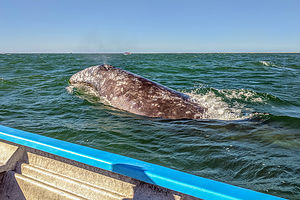 Close encounter with a gray whaleWhale watching was the major reason for us coming to Baja in the first place, and if we could actually experience these impressive mammals up close, then we would consider the trip a success. They did not disappoint.
Close encounter with a gray whaleWhale watching was the major reason for us coming to Baja in the first place, and if we could actually experience these impressive mammals up close, then we would consider the trip a success. They did not disappoint.
Baja is the place to go if you want to see gray whales, as they spend their winters there (usually from January to April) after making their long 7,000 mile journey south from the cold waters of Alaska. Tourists from around the world flock to Baja during these 4 months to see these massive, gentle animals that weigh up to 50 tons and are nearly 15 meters long.
There are three major places in Baja that they migrate to: Ojo de Liebre in Guerrero Negro, Laguna San Ignacio, and Bahia Magdalena. The shallow and protected waters of these bays are perfect for birthing and nursing calves.
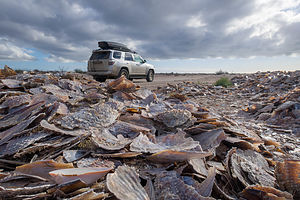 Pile of shells on road to Kuyima Eco Tour campEach of these areas offer whale-watching experiences, where you can see them spout, breach, and spyhop (vertically poking its head out of water to take a look around). Unlike other whale-watching destinations, the gray whales of Baja actually seek out human contact and will often come right up to the boats, allowing themselves to be touched.
Pile of shells on road to Kuyima Eco Tour campEach of these areas offer whale-watching experiences, where you can see them spout, breach, and spyhop (vertically poking its head out of water to take a look around). Unlike other whale-watching destinations, the gray whales of Baja actually seek out human contact and will often come right up to the boats, allowing themselves to be touched.
We chose Laguna San Ignacio, because it is regarded as the best place to experience a close-up encounter with the whales. The Laguna, which is located 33 miles southwest of the town of San Ignacio, has several eco tour operators offering whale-watching excursions - from single day 3-hour trips to 3-4 day packages where you stay in a cabana and go out each day. There are also options to camp, either with your own equipment or theirs.
Before leaving home, we had reserved two nights of camping, with our own equipment, and a 3-hour whale watching excursion with Kuyima Eco Tours. It cost us in U.S. dollars, $50 per person for the whale watching boat tour and $7 per night for camping - a bargain considering the experience is truly priceless.
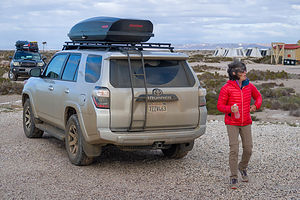 A bit windy at the Kuyima Eco Tour campWhen we arrived in the town of San Ignacio, we stopped in the Kuyima office to confirm our reservation. From there, we drove the 33 mile road out to the lagoon. The road is paved the first 27 miles, and the remaining 6 miles of dirt road were easily navigable.
A bit windy at the Kuyima Eco Tour campWhen we arrived in the town of San Ignacio, we stopped in the Kuyima office to confirm our reservation. From there, we drove the 33 mile road out to the lagoon. The road is paved the first 27 miles, and the remaining 6 miles of dirt road were easily navigable.
Upon arrival we were greeted by a very friendly, English-speaking staff member named Adriana, who showed us our campsite and explained the facilities, which consisted of environmentally-friendly toilets, sun-heated freshwater showers, drinkable water for cooking and washing, and a dining palapa offering reasonably-priced meals.
The weather was windy and freezing, so we put on every bit of warm clothing we had packed. There would be no sun-heated shower for us tonight.
The campsite location was lovely, set atop a small bluff overlooking the lagoon and the pangas we would be going out in tomorrow morning. We got out our chairs and a glass of wine and watched the changing light of a beautiful sunset over the lagoon.
 Low tide in Laguna San IgnacioWhen it got dark, we took out our cooking gear and made our standard backpacking feast - Idahoan powdered potatoes and two pouches of Starkist lemon chicken, which is surprisingly tasty and much better than the freeze-dried commercial stuff.
Low tide in Laguna San IgnacioWhen it got dark, we took out our cooking gear and made our standard backpacking feast - Idahoan powdered potatoes and two pouches of Starkist lemon chicken, which is surprisingly tasty and much better than the freeze-dried commercial stuff.
Adriana came around to our campsite to tell us that our whale-watching tour was moved up from 10 am to 8 am to try to beat the strong winds that were forecasted tomorrow. I really hoped this would come off, as seeing the whales was the main reason we had driven 1,200 miles to this lagoon.
Because of the strong winds, we decided to sleep in the back of the 4Runner rather than set up a tent. Herb had built a nice sleeping platform in the back for just these types of occasions. My main problem with the platform is that there is only about a 6 inch clearance above my face when I am lying down, making me feel a bit claustrophobic, but it’s fine as long as I don’t think about it too much.
 Campers gathered for dinner in cozy palapaWe actually slept quite well and woke up to a sunny, but chilly morning. The winds weren’t too bad yet, so we were hopeful. Our camping neighbors came over to say hi. They were a couple from San Diego that absolutely loved Baja and came down every year to spend several weeks. Their knowledge of the peninsula was invaluable, so we planned to get together after the boat tour so that they could mark up our Baja maps with places to see.
Campers gathered for dinner in cozy palapaWe actually slept quite well and woke up to a sunny, but chilly morning. The winds weren’t too bad yet, so we were hopeful. Our camping neighbors came over to say hi. They were a couple from San Diego that absolutely loved Baja and came down every year to spend several weeks. Their knowledge of the peninsula was invaluable, so we planned to get together after the boat tour so that they could mark up our Baja maps with places to see.
It was really cold, so we basically put everything we had on. I had five layers on top, the last three being a winter jacket, another down winter jacket, and a rain jacket to protect my down jacket from water. Long johns beneath long plants, gloves, and water shoes completed my outfit. Meanwhile, I had packed mostly sundresses and shorts for this trip, which I feared would never see the light of day.
We gathered near the pangas where we were given our life jackets and instructions as to where we could and couldn’t touch the whales, if the opportunity to do so arose. They also explained that whale watching in Baja is highly regulated, so our time in the section of the lagoon where the whales hung out was limited to 90 minutes, so that each eco tour operator would have their chance.
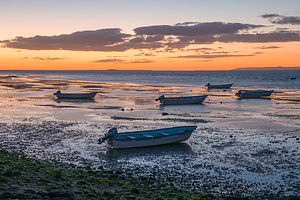 Our ride for tomorrows whale-watching tourSince we were going out in low tide, we had to wade out to and climb into the pangas. I felt pretty smug that I had brought water shoes, while most people had to take off their sneakers, but not so much so after I realized that I had worn small socks, which became and remained totally drenched during the entire trip.
Our ride for tomorrows whale-watching tourSince we were going out in low tide, we had to wade out to and climb into the pangas. I felt pretty smug that I had brought water shoes, while most people had to take off their sneakers, but not so much so after I realized that I had worn small socks, which became and remained totally drenched during the entire trip.
Although the pangas could accommodate 8, we were fortunate to have only 6 people, plus Max, our captain. We moored out towards the opening of the lagoon, where the 120 or so gray whale inhabitants like to hang out. When we got there, Max just idled the engine and we waited.
It wasn’t long before we saw our first whale breach in the distance. Excitedly, everyone said “There’s one,” and pointed. Then another one and another one appeared, and soon they were so common that no one felt the need to announce them. Mostly they breached, sometimes flipping their tail in the air, but sometimes they spyhopped, which meant vertically poking their heads out of water to take a look around.
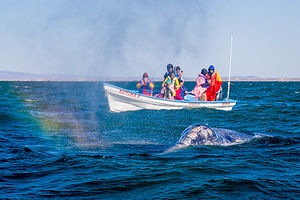 Rainbow whale spoutThey were really difficult to photograph because everything happened so quickly. Although many came within a few feet of the boat, we were never able to actually touch one, but that didn’t really diminish this amazing experience.
Rainbow whale spoutThey were really difficult to photograph because everything happened so quickly. Although many came within a few feet of the boat, we were never able to actually touch one, but that didn’t really diminish this amazing experience.
Our 90 allotted minutes in the whale watching zone went by so quickly, and we were so mesmerized with watching the whales that we didn’t notice that indeed the wind had picked up and there were now whitecaps in the lagoon. However, Captain Max got his 6 very satisfied passengers back to camp safe and almost dry. Everyone was exuberant about what they had experienced.
Back at camp, we had to decide what to do next. It was not even noon yet, and the winds were going to just get stronger and stronger as the day went on. Since we were not going out on another tour tomorrow, we decided to not camp that night, but to move on, as there were so many places we wanted to still see.
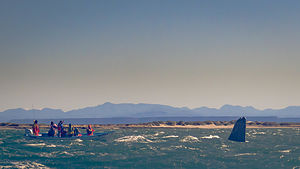 Spyhopping in the Lagunaefore leaving, however, we had a cup of coffee with John and Mary, our Baja expert neighbors, in the cozy and warm palapa where we spent an hour marking up our Baja maps with places they recommended to see, including many off-road adventures.
Spyhopping in the Lagunaefore leaving, however, we had a cup of coffee with John and Mary, our Baja expert neighbors, in the cozy and warm palapa where we spent an hour marking up our Baja maps with places they recommended to see, including many off-road adventures.
We said our goodbyes and headed back along the road to the lovely town of San Ignacio, where we thought we might spend the night. Realizing Kuyima had only charged us for the deposit, we stopped in the office near the plaza to pay the balance - quite trusting on their part.
We spent some time wandering around the square, where there is a beautiful mission and picturesque examples of colonial architecture. This was by far, the nicest town we had seen yet. What we were to continue to learn is that the towns in Baja Sur were much better kept, preserved, and attractive than in the north, perhaps because of (or the result of) the influx of tourists.
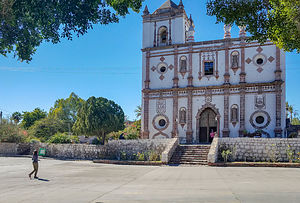 Mision San IgnacioAlthough spending the night in San Ignacio would have been fun, our time in Baja was limited, and we had so much we wanted to see. So we decided to drive on for a few hours, trying to stop for the night at Eco Tour Las Tres Virgenes (with the virgins being three stunning dormant volcanoes).
Mision San IgnacioAlthough spending the night in San Ignacio would have been fun, our time in Baja was limited, and we had so much we wanted to see. So we decided to drive on for a few hours, trying to stop for the night at Eco Tour Las Tres Virgenes (with the virgins being three stunning dormant volcanoes).
Description
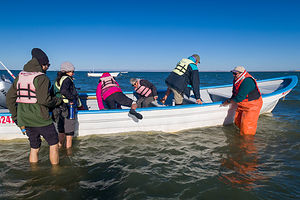 Boarding our pangaEvery October, gray whales begin their 7,000-mile migration from the cold waters of the Alaskan seas to the warm lagoons of Baja California Sur, where they mate and give birth to their calves. The journey, which takes them two to three months, is the longest annual migration of any mammal.
Boarding our pangaEvery October, gray whales begin their 7,000-mile migration from the cold waters of the Alaskan seas to the warm lagoons of Baja California Sur, where they mate and give birth to their calves. The journey, which takes them two to three months, is the longest annual migration of any mammal.
Arriving in January, they remain until about April before returning north. During those four months, tourists from around the world flock to Baja to see these massive, gentle animals that weigh up to 50 tons and are nearly 15 meters long.
There are three major places in Baja that they migrate to: Ojo de Liebre in Guerrero Negro, Laguna San Ignacio, and Bahia Magdalena. The shallow and protected waters of these bays are perfect for birthing and nursing calves.
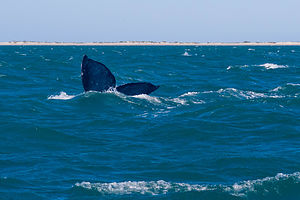 Whale tailEach of these areas offer whale-watching experiences, where you can see them spout, breach, and spyhop (vertically poking its head out of water to take a look around). Unlike other whale-watching destinations, the gray whales of Baja actually seek out human contact and will often come right up to the boats, allowing themselves to be touched.
Whale tailEach of these areas offer whale-watching experiences, where you can see them spout, breach, and spyhop (vertically poking its head out of water to take a look around). Unlike other whale-watching destinations, the gray whales of Baja actually seek out human contact and will often come right up to the boats, allowing themselves to be touched.
Whale watching in Baja is highly regulated and the number of boats allowed in the lagoons at one time is tightly controlled. Guides take out groups of 6-8 people at a time in small, very seaworthy, fishing boats called pangas.
Laguna San Ignacio is regarded as the best place to experience a close-up encounter with the whales. The Laguna, which is located 33 miles southwest of the town of San Ignacio, has several eco tour operators offering whale-watching excursions - from single day 3-hour trips, to 3-4 day packages where you stay in a cabana and go out each day. There are also options to camp, either with your own equipment or theirs.
It is an experience not to be missed.
- ‹ previous
- 4 of 14
- next ›
Kuyima Eco Tour Whale Watching Camp location map in "high definition"
Javascript is required to view this map.

Thank you so much for this information; traveling to Baja to see the whales in March. Loved your descriptions of this outing as well as ventures in Loreto and Bahia Concepcion. Great blog!
Thanks Julie Brokmeyer for your comment,
Apologies for the late response, but our system was down for a bit.
Glad you found something of use in our description of Whale Watching in Kuyima. We have got to get back there again!
Safe travels, Herb